Are you a Quiet Speculation member?
If not, now is a perfect time to join up! Our powerful tools, breaking-news analysis, and exclusive Discord channel will make sure you stay up to date and ahead of the curve.
This format has become as hostile as Zendikar. Testing Eldrazi online makes everyone ragequit, and testing anything else leaves me with bruises. Last week, I took a deck I’d already worked on profusely and tweaked it into a hate-machine for the format tyrant. The deck showed initial promise, but soon Eldrazi opponents adapted to my strategy, and I started losing.
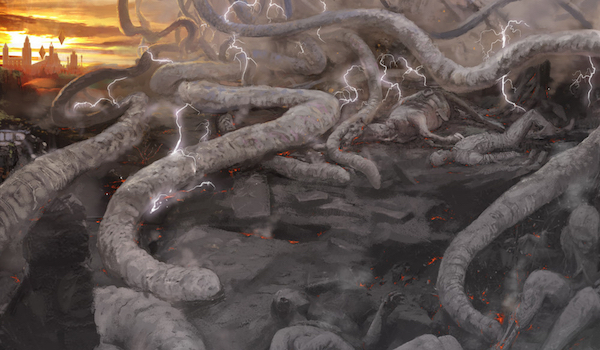
The Modern we know and love is gone. In this article, I’ll detail my final experiences with GRx Moon before abandoning the archetype completely, and give my take on what exactly makes these Eldrazi decks so “fundamentally broken.”
[wp_ad_camp_1]
Last Resort: Powder Moon
Last week, I talked about "canaries in a coal mine," or historically unplayed Modern cards 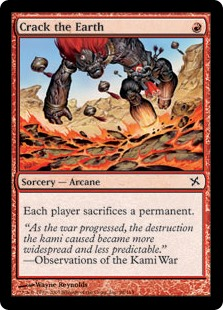 whose presence indicates a deep imbalance in the format. I presented a GRx Moon deck featuring an obvious canary in Crack the Earth. Some intensive testing in the days following that article's publication led me to wonder whether Crack was even worth it in the shell. Attentive Eldrazi opponents played around it in games two and three, leading with low-value lands and dispensable permanents like Eldrazi Mimic or Relic of Progenitus. In the late-game, Crack proved all but dead, allowing opponents to sacrifice their worst permanent on board and hardly affecting the game.
whose presence indicates a deep imbalance in the format. I presented a GRx Moon deck featuring an obvious canary in Crack the Earth. Some intensive testing in the days following that article's publication led me to wonder whether Crack was even worth it in the shell. Attentive Eldrazi opponents played around it in games two and three, leading with low-value lands and dispensable permanents like Eldrazi Mimic or Relic of Progenitus. In the late-game, Crack proved all but dead, allowing opponents to sacrifice their worst permanent on board and hardly affecting the game.
I wasn't ready to give up on GRx Moon just yet. After all, in a format dominated by a deck wielding so many nonbasics, there had to be a spot for the archetype. The games I lost against Eldrazi were the ones where I couldn't resolve a Moon on turn two or earlier. Since Magic only lets us run four copies of a card, I needed to introduce a new canary to maximize the odds of hitting my relevant disruption on time: Serum Powder. Powder has never worked in this archetype before, but in such a high-pressure environment, I wondered if it wasn't necessary for the starts I needed. It's been great for me in Eldrazi shells, so why not try it here? After some tuning, I landed on this list:
Powder Moon, by Jordan Boisvert
Building the Deck
I know this deck reads like a pile of trash. It used to be much cleaner. The mainboard originally looked like this:
-2 Tarfire
-2 Forked Bolt
-1 Dismember
-2 Huntmaster of the Fells
+2 Lightning Bolt
+4 Goblin Rabblemaster
+1 Serum Powder
I won’t go too deep on the card choices here, but rapidly growing Goyf past Reality Smasher was important enough to shave Bolts for Tarfires. Forked Bolt plugged some other holes and answers Skyspawners at parity, and Rabblemaster got walled too often for my taste. Huntmaster of the Fells, on the other hand, allowed me to stabilize the board and dealt a hefty amount of damage just by flipping back and forth. Eventually, I could alpha strike opponents with a bunch of Wolf tokens.
Testing it Out
For testing, I started with six unsided games against a friend piloting my take on Colorless Eldrazi. Here's that, for reference:
Colorless Eldrazi, by Jordan Boisvert
We made one major change to bring the deck closer to online versions, cutting four Serum Powder for two Ratchet Bomb and two Spellskite. On paper, this change should benefit the Moon deck, since Powder gives Eldrazi a way to make colorless under the iconic enchantment. Here are my results:
- On the play: 0-3
- On the draw: 3-0
We couldn't believe it. Why would the Moon deck lose on the play, but not on the draw? Even more absurd, in each of those on the play games I lost, I cast turn one Blood Moon. A damning combination of Eldrazi Mimic, Endless One, and Dismember destroyed me in these games before I could stabilize the board.
 The resources necessary to cast turn one Blood Moon left me too down on cards to chase the lock piece with game-winning cards like Huntmaster. We did another six games without sideboarding, and I resolved not to slam my Moons on turn one. The new numbers:
The resources necessary to cast turn one Blood Moon left me too down on cards to chase the lock piece with game-winning cards like Huntmaster. We did another six games without sideboarding, and I resolved not to slam my Moons on turn one. The new numbers:
- On the play: 1-2
- On the draw: 2-1
A similar story, although we each got a game in on the play this time. To combine the numbers, our twelve games yielded these results:
- On the play: 1-5
- On the draw: 5-1
The 6-6 game split doesn't give me great confidence in GRx Moon's ability to stop Eldrazi.  Powder Moon is basically pre-borded against the colorless menace, so if all we can manage is to tie things up, I don't think these results even warrant any sideboarded games. If this hate-filled deck had any real promise, it would at least boast a 60% win rate against its supposed prey.
Powder Moon is basically pre-borded against the colorless menace, so if all we can manage is to tie things up, I don't think these results even warrant any sideboarded games. If this hate-filled deck had any real promise, it would at least boast a 60% win rate against its supposed prey.
Powder Moon also seems worse going forward. For one, I tested the deck against Colorless Eldrazi, a stompy deck with fewer pilots by the event. Players seem to be migrating en masse towards more aggressive Ux builds and heavily metagamed GR versions, which doesn't bode well for GRx Moon in general. I mostly lose games to wide fields of x/2s and x/1s against the blue Eldrazi decks (explaining the pair of Anger of the Gods in my sideboard), and Kozilek's Return from the GR deck can easily dispatch a growing Huntmaster army. That variant even runs Mind Stone sometimes, meaning Blood Moon won't necessarily cut opponents off colorless.
What Makes Eldrazi So Good?
Sheridan's latest article gives us even more hard numbers pointing to Eldrazi's inherent brokenness. But this revelation is hardly news for Modern aficionados. As early as before the Pro Tour, major websites published articles calling for an Eldrazi Temple ban. After the tournament, pros were quick to peg the deck as “fundamentally broken," pointing specifically to its lands. By now, everyone knows Eldrazi is busted in Modern. I’m still not convinced everyone knows why.
Sol Lands: Card Advantage and Speed
In "Turn Four Ulamog: Reshaping Modern with Eldrazi Stompy", we explored the obscene power of Sol lands, which simultaneously provide card advantage and speed. A brief recap:
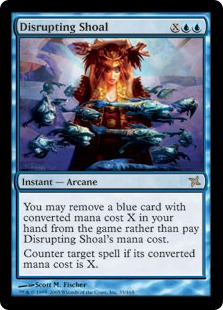 Achieving great speed generally comes at the cost of card disadvantage. In Temur Delver, Disrupting Shoal chews through our hand so we can create a board state so favorable that a single Mana Leak (read: Time Walk) brings the game home. In ritual-based builds of GRx Moon, Simian Spirit Guide and Desperate Ritual allow us to trade one card for one mana, enabling us to resolve Blood Moon a crucial turn earlier.
Achieving great speed generally comes at the cost of card disadvantage. In Temur Delver, Disrupting Shoal chews through our hand so we can create a board state so favorable that a single Mana Leak (read: Time Walk) brings the game home. In ritual-based builds of GRx Moon, Simian Spirit Guide and Desperate Ritual allow us to trade one card for one mana, enabling us to resolve Blood Moon a crucial turn earlier.
Conversely, accruing card advantage should cost players speed. For a classic example of this principle, we need look no further than Divination. This sorcery puts us up one card, but it asks us to spend three mana during the main phase, hindering our board development. Treasure Cruise, Gush, and Necropotence all violate this rule, giving pilots a hand full of cards for minimal mana investment. To an extent, so does Dark Confidant; as long as Bob exists in a format where a 2/1 for 1B holds some relevance, his upside of drawing a card per turn at the cost of mere life ensure his staple status.
Based on these analyses, speed and card advantage should not exist in the same place. When they do, broken decks emerge - take Treasure Cruise Delver, GAT, and Trix as examples. Unfortunately, since Sol lands act as two lands in one, they put players up a card just by being in play. And since they tap for two mana, they also provide speed, allowing Eldrazi pilots to operate twice as quickly as their opponents.
Who's the Beatdown?
We’ve established that Eldrazi’s lands allow it to operate on an axis separate from that of most Modern decks. But how does its brokenness manifest during a game?
Many of you have read Mike Flores’ classic "Who’s the Beatdown?” In this article, Flores examines the importance of knowing your role in a matchup. To quote him directly:
"Let me give you an example: At a 1.x PTQ in Washington D. C., my teammate Al Tran was playing for a top 8 slot vs. Sligh. Al was playing Lan D. Ho's White weenie/Jank deck, normally an aggressive deck... But not vs. Sligh.
[…]
Al was a beatdown deck, and he wanted to deal damage to his opponent via the Jackal Pups. However, in this particular matchup, he had to play the control deck. You see, Sligh is just much faster than Jank, so Jank's way to win has to be stifling Sligh's early speed with removal, and then locking down the midgame with Cursed Scrolls. Because Sligh also has Cursed Scrolls, as well as more Bolts than Jank, the only way that Jank can win is to make sure it has a decent life total as it plays its own threat cards."
When I play Temur Delver against Affinity, I’m unfavored in game one because Affinity is much faster than me. I’d rather be the control in this matchup, but my control tools are in the sideboard. If I try to be the control in game one, I'll run out of disruption faster than Affinity runs out of Cranial Platings. Subsequently, I often lose game one because I have no choice but to be the beatdown and try to race my opponent. In practice, it usually looks like this:
Turns 1-2: Play threats. Start attacking.
Turns 3+: Disrupt Affinity. Vapor Snag, Mana Leak, etc.
After siding, things change drastically; I have Huntmaster of the Fells, Ancient Grudge, and Pyroclasm to lean on, and can easily take on my preferred control role in this matchup. Now, my role is inverted: I disrupt the Affinity player with removal and board wipes, then land a Tarmogoyf or Huntmaster to carry the game away. By the time those creatures land, Affinity should be out of gas. Another visual:
Turns 1-3: Disrupt Affinity. Lightning Bolt, Pyroclasm, Ancient Grudge, etc.
Turns 4+: Play threats. Start attacking.
When I started brewing Monkey Grow, I lost many matches to Affinity because I simply didn’t know what I wanted to be doing in the matchup yet; I hadn’t established whether I was the control or the beatdown, or when I would switch.
Having it All
 Against a deck as fast as Affinity, most decks opt to take the control role. Eldrazi has an early game that’s just as explosive, rendering a beatdown plan unattractive; nobody wants to cast Goblin Guide and Wild Nacatl when opponents can match these threats with Thought-Knot Seer and Reality Smasher. But taking a control role against Eldrazi proves just as dangerous, since the tutoring power of Eye of Ugin gives the deck a late-game as solid as Tron’s. Should you run Eldrazi out of gas, the Eye threatens to take the whole game back unless you can now kill them right away. Additionally, GR plays to a long game with World Breaker recursion or Ulamog, the Ceaseless Hunger, and UW can even deck players out with Eldrazi Displacer and Thought-Knot Seer.
Against a deck as fast as Affinity, most decks opt to take the control role. Eldrazi has an early game that’s just as explosive, rendering a beatdown plan unattractive; nobody wants to cast Goblin Guide and Wild Nacatl when opponents can match these threats with Thought-Knot Seer and Reality Smasher. But taking a control role against Eldrazi proves just as dangerous, since the tutoring power of Eye of Ugin gives the deck a late-game as solid as Tron’s. Should you run Eldrazi out of gas, the Eye threatens to take the whole game back unless you can now kill them right away. Additionally, GR plays to a long game with World Breaker recursion or Ulamog, the Ceaseless Hunger, and UW can even deck players out with Eldrazi Displacer and Thought-Knot Seer.
To reliably beat Eldrazi, interactive decks must disrupt, then commit, then disrupt again. Thanks to the resources and right-time answers necessary, few decks are able to consistently play this way. In practice, it looks like this:
Turns 1-3: Disrupt Eldrazi. Spreading Seas, Dismember, Path to Exile, etc.
Turns 4-7: Play threats. Start attacking.
Turns 7-10: Disrupt Eldrazi. Mana Leak, Cryptic Command, Remand, etc.
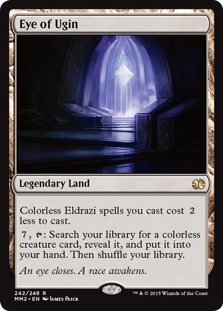 On turns 4-7, the threats come down to pressure an immobilized Eldrazi player. Even without considering that Eye of Ugin becomes active in a couple turns, this plan doesn’t really work. The reason: threats that come down for 2-5 mana can’t really tangle with cards like Reality Smasher, which opponents can topdeck at any time. 4/5 Goyfs, Batterskull tokens, Tasigurs, and Siege Rhinos are immediately outclassed, presenting nasty new roadblocks in the three-turn window players have to beat Eldrazi. Not that it would actually predate Eldrazi, but only Splinter Twin has a reasonable way to kill opponents in that tiny window.
On turns 4-7, the threats come down to pressure an immobilized Eldrazi player. Even without considering that Eye of Ugin becomes active in a couple turns, this plan doesn’t really work. The reason: threats that come down for 2-5 mana can’t really tangle with cards like Reality Smasher, which opponents can topdeck at any time. 4/5 Goyfs, Batterskull tokens, Tasigurs, and Siege Rhinos are immediately outclassed, presenting nasty new roadblocks in the three-turn window players have to beat Eldrazi. Not that it would actually predate Eldrazi, but only Splinter Twin has a reasonable way to kill opponents in that tiny window.
We’ve seen similar Catch-22 situations in the past, with decks like UR Delver. You could Pyroclasm away their threats, but they would respond with a Treasure Cruise and flood the board all over again. While Affinity gives up the late game and a resilience to sweepers for strong starts, and midrange decks sacrifice early game points to dominate later on, Eldrazi has its yummy Gatewatch cake and eats it, too.
Copwatch: Policing the Police
The final issue with Eldrazi is that its natural checks are easily checked. We can dismantle Affinity’s “nut draw” with a Pyroclasm or a Shatterstorm, but no such card exists to erase Thought-Knot Seer and Reality Smasher. Modern’s available options, like Supreme Verdict, cost a whopping four mana, meaning players need to topdeck them at the right time or pray opponents don’t draw a Thought-Knot Seer before turn four.
If interacting is such a losing proposition in this metagame, why not just go linear and hope to race? For three reasons:
- Eldrazi interacts with linear decks quite well. Turn one Chalice of the Void, turn two Thought-Knot Seer, turn three Ensnaring Bridge, and turn four Worship are all viable Eldrazi plans, not to mention the constant threat of Dismember with Simian Spirit Guide (or Gut Shot without it).
- Eldrazi can painlessly pack checks to linear strategies. Stony Silence, Spellskite, Relic of Progenitus, and Ratchet Bomb invalidate a host of otherwise feasible strategies.
- Eldrazi is a faster linear deck. At the Pro Tour, we saw Eldrazi decks goldfish turn three and turn four victories against helpless opponents. LSV’s Eldrazi article on Channel Fireball even opens by outlining a possible turn two kill.
It seems on the surface like Affinity might be poised to beat Eldrazi. Austin Holcomb defeated 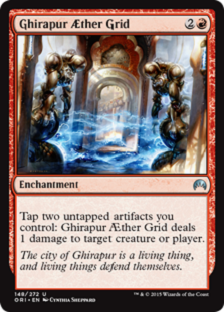 UW Eldrazi in the Louisville finals last weekend, by transforming into Lantern Control with the esoteric combination of Ghirapur Aether Grid and Ensnaring Bridge in the sideboard. Really, two decks beat Eldrazi in the finals, not one. The Eldrazi decks of the future can prepare for this combo with more Disenchants, but Holcomb’s victory doesn’t signal a period of Affinity dominating Eldrazi for another reason. To quote Sheridan’s Wednesday piece, “When your best police deck is so easily counter-policed, the format is in trouble.” Stony Silence, Hurkyl's Recall, and Ancient Grudge all give Affinity a hard time, and in Eldrazi colors. A distinct lack of efficient hosers for Eldrazi decks all but guarantees Modern will be crawling with the colorless critters until April.
UW Eldrazi in the Louisville finals last weekend, by transforming into Lantern Control with the esoteric combination of Ghirapur Aether Grid and Ensnaring Bridge in the sideboard. Really, two decks beat Eldrazi in the finals, not one. The Eldrazi decks of the future can prepare for this combo with more Disenchants, but Holcomb’s victory doesn’t signal a period of Affinity dominating Eldrazi for another reason. To quote Sheridan’s Wednesday piece, “When your best police deck is so easily counter-policed, the format is in trouble.” Stony Silence, Hurkyl's Recall, and Ancient Grudge all give Affinity a hard time, and in Eldrazi colors. A distinct lack of efficient hosers for Eldrazi decks all but guarantees Modern will be crawling with the colorless critters until April.
The Horrible Future Is Now
Eldrazi Temple’s flavor text couldn’t have turned out more accurate. Along with Eye of Ugin, the card helped create the most oppressive deck Modern has ever seen. I still look forward to GP Detroit. As much as I wanted to play Delvers at that tournament, I think it’s good of Wizards to hold off on banning Eldrazi cards until April, lest they set an unfortunate precedent. But Eldrazi won't back down in the next few weeks. Good luck to everyone representing the Gatewatch - I’m siding with Endbringer for this one.





Curious – is there any sort of consensus on whether it would take a temple ban, eye ban, or both to dampen the eldrazi deck down to a reasonable level?
I’ve personally not seen many folks advocate banning both, but I haven’t seen much consensus on which one to ban. But that’s just my anecdotal observations. Not sure if anybody has hard data in that regard.
Not that I’ve seen. Wizards has a history of banning both offenders (Cruse/Dig, Nacatl/Fire, etc.), but I think if they just banned Temple the deck would slow to a manageable level. That said, I haven’t tested it.
I do think banning temple is better than eye of ugin. I mean you can still do explosive Eldrazi Mimics turn 1 with Eye but this kind of play sounds more like a glass cannon than a real offender. The biggest offender right now is being able to do that turn 1 Mimics than a turn 2 Thought-Knot Seer via Eldrazi Temple.
Eye of Ugin is legendary so having multiples are horrible since you can’t float mana or even “float” cost reduction by other hand starting with multiple Temples will always be a good hand. Temples allow turn 2 Thought-Knot Seer if you keep playing Temples. Eye of Ugin lets you have a turn 3 Thought-Knot Seer and would force players to play other colorless lands to not only rely on Temple. Banning both lands would be the worst decision ever.
To be realistic I think that Wotc do not want to emergency ban something right now not because It is not needed but because they do not want to look like they are amateurs and don’t know what they are doing with modern. I mean specially because things gone crazy just few weeks after that polemic Twin ban.
Eternal Master announcement instead a Modern Masters 3 release sounds more like a bad joke. Something to change people focus from Modern Eldrazi mess to another eternal format that they really never gave any sort of support (besides commander products). Until few weeks ago they had stated that legacy would be more an online format than a paper one. Now they tell something more like “hey people Force of Will! Look we are printing Force of Will!!! Stop looking and talking about eldrazi, look we are giving you Force of Will!!”
Temple and Ugin were never a big problem until Oath’s release. They said that they only think about card design in standard and not eternal formats. Are they nuts? Why don’t they hire a team to see how some cards would interact in older formats? It would cost less than trying to fix the format after every set release.
From what I’ve seen the agreement is that Eye is the most broken piece, but it isn’t the agreed upon ban. Would not be surprised, personally, if both go but I expect one or the other.
Eye can theoretically generate upwards of six mana in a turn, but the Temple ban stops the deck from its most broken openers: turn two Thought-Knot and turn three Reality Smasher. The Smasher is still possible off Eye + Urborg + colorless source, but it’s much harder to achieve without Temple legal.
certainly forcing them to draw eye+urborg – two legendary lands – in order to have a broken opener seems a lot fairer. It means they’ll also get hands with jsut one or the other, or multiple copies of a legenday land (esp useless if its eye). Two temples can just happen every now and then, and there’s no legendary drawback to ever punish you for putting 4 of them in the deck.
I’m personally rooting for an eye ban so that tron no longer has the same inevitability against my beloved esper control deck, but that’s selfish esp in the face of the more important issue of crippling the eldrazi decks. Not gonna lie, I haven’t attended a local modern event since the pro tour. Even knowing the deck won’t be that prevalent at the LGS, its existence has just psychologically taken my interest in the format down many levels
I think it’s a slight misrepresentation to say “Eye can generate 6 mana in a single turn”, because you can’t do some of the most important things that could be done with something that *actually* produced that much mana in a turn. Eye can *conditionally* provide 6 mana in a turn, as long as any given spell is only using 2 of that.
By comparison, Temple never generates more than 2 in a turn, but the ability to have multiples means they can be stacked to focus on huge, game-breaking cards. Eye can’t do that.
When we discuss Eye by saying “It can generate 6 mana per turn” (or something along those lines), we calibrate our thinking to see the card as being much stronger than it is (compared to Temple).
I think in the end it doesn’t matter which one they ban, but stacking temples may be ok because drawing 2 or more of an important 4 of should be a nut draw. eye of ugin facilitates crazy plays at every point of the game. Even if it is not 6 mana a turn, it is for suuure 4 mana really often when dropping multiple three drops from the uw/ur version.
More importantly, I don’t think it is in wizard’s interest to kill the deck entirely so I hope they just ban one. On the other hand, if they will just have to ban the other card later because it continues to be on the same levels as pod and twin, then that is also pretty feelbads. To be honest, Wizards had really put themselves in a bind with the simultaneous twin banning and eldrazi printing. If you read the signs from them, eldrazi does seem fated to be banned to oblivion if a single ban doesn’t do it. If eldrazi continues (and affinity honestly at some point probably, not that I am calling for band, just trying to be consistent with their application of metagame shares) to be a large part of the meta, what will wizards do? Can we really be confident that either of these two decks will be around in their current form (or post April ban at least for eldrazi) in 2 years?
No matter how many times you test your canary, it would be better served to just play a better deck
That’s the conclusion I also came to. I’m not introducing canaries for the sake of introducing them – testing with GRx Moon, a deck I’ve had a lot of success with in the past, has shown me that I needed cards like Crack the Earth or Serum Powder to even approach the level of consistency needed against Eldrazi. Since those cards didn’t get me there, I’m giving up the fight and returning to the colorless legions.
Yeah, the canary decks do not really seem to work against them. I think right now Elves is one of the best decks to take against Eldrazi and the rest of the field. it has a very good matchup vs most Eldrazi decks because they have no real ways of stopping you from going totally elves on their ass.
http://mtgpulse.com/event/23562#322138
Meta full of eldrazi and 2x elves in the top 8, if you have acces to mtgpulse’s archtype analysis tool you will also see that it has a great matchup against Melira Company.
Other than that and affinity its just waiting for the april bans..
Haha, never paid attention to Eldrazi Temple’s flavor text. +1 for that.
Indeed, as much as I hate seeing what modern became, an emergency ban would be bad.
Like banning an almost broken (but not quite) deck like twin, without giving anything back to it.
Assuming no one disagrees that either temple or eye should be banned; should the deck be outright weeded out of the format, by banning BOTH eye and temple?
I think running some test lists without Temple and then without Eye (like the SfM unban test) could be very interesting and might help answer the question on what should be done. As much as I want to see the deck get nerfed so that we can have a healthy format again, I’m always happy to see new viable decks added to the Modern roster and would happily embrace a more balanced Eldrazi deck being in the format. Essentially, I want the ban to stop thisy deck from being oppressive as it is now, but hopefully without hurting it so much that it becomes completely unplayable.
This. I think most people would actually have loved for a new tier 1/tier 2 contender. People were already going crazy for the processor builds and that was not oppressive at all. Sure it sucked that gy based decks became essentially unplayable, but still a new entry into the format was sweet. People didn’t want a tier 0 oppressive monster. Sadface